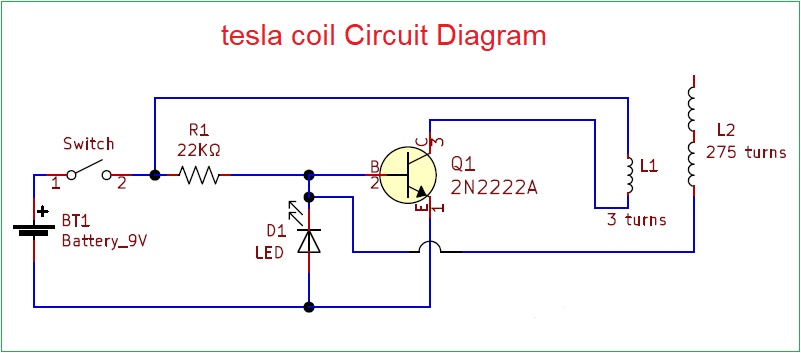Objective: To Glow Bulb Wirelessly Using a Tesla Coil
This project demonstrates the principle of Wireless Power Transmission (WPT) using a simple Tesla Coil. Inspired by Nikola Tesla's pioneering work in the late 19th century, this experiment shows how energy can be transferred without wires to light up a bulb at a distance. The core of the setup is an electrical resonant transformer circuit. A high-frequency transistor (like the 2N2222) supplies current through the primary coil, powered by a 9V battery. The oscillating current in the primary coil generates a magnetic field, which induces a strong electric field in the secondary coil. This field is powerful enough to light up CFL bulbs placed nearby, demonstrating the concept of wireless energy transfer.
How to Build a Simple Tesla Coil Wireless Bulb Project
- Wind the Secondary Coil: Use fine copper wire and a plastic tube. The more turns, the higher the voltage.
- Prepare the Primary Coil: Use thicker copper wire and wind a few turns around the base of the secondary coil.
- Assemble the Circuit: Connect the transistor, LED, coils, and battery as shown in the circuit diagram.
- Insulate and Secure: Use insulating tape to prevent shorts and secure the coils.
- Test the Setup: Place a CFL bulb near the secondary coil and power the circuit. The bulb should glow wirelessly!
Tip: Try different coil sizes and distances for best results. Always follow safety precautions!
A Brief History of Tesla Coil
The Tesla Coil, invented by Nikola Tesla in 1891, was a revolutionary device for generating high-voltage, low-current, high-frequency alternating-current electricity. Tesla's vision was to transmit electricity wirelessly across great distances. While his dream of global wireless power remains unrealized, the Tesla Coil is still used today for educational demonstrations, radio technology, and even entertainment in musical Tesla coil shows.
How Does It Work?
The positive terminal of the battery connects to the collector of the transistor through the primary coil, while the emitter is grounded. When the transistor conducts, current flows through the primary coil. The base of the transistor is connected to the LED and one end of the secondary coil, causing the circuit to oscillate. This oscillation produces a rapidly changing magnetic field, which induces a high voltage in the secondary coil. The energy is strong enough to light up a bulb wirelessly, even if it is not physically connected to the circuit.
Circuit Diagram

Components Required
- 9V Battery
- 2N2222 High-Frequency Transistor
- Primary Coil (few turns of copper wire)
- Secondary Coil (many turns of fine copper wire)
- LED Diode
- CFL Bulb
- Connecting Wires
- Breadboard or PCB
- Insulating Tape
- Plastic Tube (for winding coils)
Assembly & Construction Tips
Carefully wind the secondary coil with as many turns of fine copper wire as possible on a plastic tube for maximum voltage induction. Ensure the primary and secondary coils are insulated from each other. Use insulating tape to secure windings and prevent short circuits. Place the CFL bulb near the secondary coil for best results.
Working Model Demonstration
Applications & Advantages
- Demonstrates the principle of wireless power transfer
- Educational tool for physics and electronics students
- Foundation for wireless charging technologies
- Can be scaled for higher power transmission
- Safe and simple for classroom demonstrations
- Great for science fairs and STEM exhibitions
- Inspiration for modern wireless charging pads
Limitations & Challenges
While this project is safe and educational, the power transmitted is low and suitable only for small loads like CFL bulbs. Efficiency drops rapidly with distance, and the system is sensitive to coil alignment and environmental interference. For higher power or longer range, more advanced designs and safety precautions are needed.
Safety Precautions
- Always use low voltage (9V battery) for demonstration
- Do not touch the coil terminals while powered
- Keep away from sensitive electronic devices
- Ensure proper insulation of wires
- Supervise children during experiments
- Avoid using near pacemakers or medical devices
Further Exploration
- Experiment with different coil sizes and turns for efficiency
- Try powering different types of bulbs or small devices
- Research modern wireless charging systems (Qi, resonant coupling)
- Explore Tesla's original patents and experiments
- Integrate with microcontrollers for smart switching
- Build a musical Tesla coil for audio demonstrations
Frequently Asked Questions (FAQ)
- Q: Can I use a different transistor? A: Yes, any high-frequency NPN transistor like BC547 can work, but 2N2222 is recommended for stability.
- Q: Why is my bulb not glowing? A: Check coil windings, connections, and ensure the bulb is a CFL or fluorescent type.
- Q: Is this safe for kids? A: Yes, if you use a 9V battery and follow safety precautions.
- Q: Can I use this for wireless phone charging? A: No, this is a basic educational demo. Wireless phone charging uses more advanced, efficient, and safe circuits.
Conclusion: This wireless bulb project is a hands-on introduction to the fascinating world of wireless power transmission. By understanding and experimenting with Tesla coil principles, you gain insight into both classic and modern applications of electromagnetic induction. For more projects and tutorials, explore the rest of my portfolio!
Related Resources & References
- Nikola Tesla Biography (Wikipedia)
- How Wireless Power Works (ExplainThatStuff)
- Tesla Coil Project on Instructables